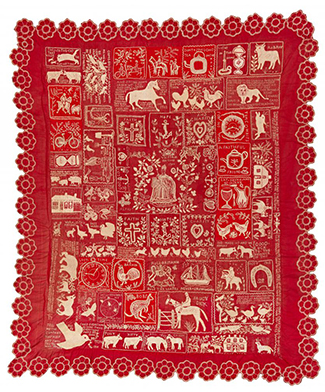 Australia’s rich quilt heritage, resplendent with imagery of native flora and fauna, early coats of arms and motifs of daily colonial life, will be revealed in a new exhibition at the National Gallery of Victoria in Making the Australian Quilt: 1800–1950.
Australia’s rich quilt heritage, resplendent with imagery of native flora and fauna, early coats of arms and motifs of daily colonial life, will be revealed in a new exhibition at the National Gallery of Victoria in Making the Australian Quilt: 1800–1950.
In an Australian exclusive, the exhibition will bring together more than 80 stunning quilts, coverlets and patchwork fashion garments, as well as examples of intricate quilting techniques.
“Making the Australian Quilt: 1800–1950 will uncover remarkable personal stories of Australian character, ingenuity and thriftiness through the lens of our nation’s quilting legacy,” said Tony Ellwood, Director NGV.
“Showcasing important works from public and private collections across the country, the exhibition will provide an insight into the skills and technical virtuosity of these women, and men, whose works chronicle the history of Australia, stitch by stitch.”
A highlight of the exhibition is the renowned The Rajah Quilt, 1841, on loan from the National Gallery of Australia and considered one of Australia’s most important textiles. The work is the only surviving example of a quilt made by convicts on the long and treacherous three-month sea voyage from London to Van Diemen’s Land.
Thought to have been hand stitched by more than 29 female convicts aboard the ship, The Rajah Quilt is decorated with bird and floral designs, and very rarely displayed due to its fragility and light-sensitivity. A second convict quilt, created in 1811 and only recently discovered, will also be exhibited for the first time.
Co-curators of Making the Australian Quilt, quilt historian and collector Dr Annette Gero and Katie Somerville, Senior Curator, Fashion and Textiles, NGV, have included an astonishingly diverse array of materials which are telling of the creative resourcefulness of their makers; from taffeta, velvet, furnishing fabric and dressmaking scraps to flour bags, possum skins, suiting samples and flannelette, each transformed by the act of cutting, layering, piecing and stitching.
Many works in the exhibition were created within intimate, private settings, yet have the ability to convey much of their broader social and historical significance. Renowned local makers such as Mary Jane Hannaford, Marianne Gibson and Amelia Brown developed unique styles which reveal the rise of an Australian identity, demonstrating the emergence of early symbols of Australian nationhood, such as flags, coats of arms and patriotic phrases, and the shift away from prevailing British traditions and emblems of the British Empire.
The exhibition also encompasses quilts created as expressions of love and connection including treasured family heirlooms which have been carefully stored in Australian homes and attics for generations. An elaborate ball gown worn to the Mayor of Melbourne’s fancy dress ball in 1866, pieced together with custom printed silk satin images of pages from 14 different Melbourne newspapers, including The Age, The Australasian, Herald and Punch, is another highlight.
Primarily featuring works made in Australia or with a significant Australian provenance, the exhibition additionally includes key 19th century English quilts that were brought or sent to Australia, informing and influencing the early quilting practices of local makers. Making the Australian Quilt also shows that quilting was not exclusive to women makers and will offer examples made by a sailor and a prisoner of war.
Making the Australian Quilt: 1800–1950
The Ian Potter Centre: NGV Australia, Federation Square, Melbourne
Exhibition: 22 July – 6 November 2016
Admission fees apply
For more information, visit: www.ngv.vic.gov.au for details.
Image: Misses Hampson, active in Australia (early 20th century) The Westbury quilt (Sampler quilt) c. 1900–03 cotton (flannel) (embroidery and applique) 200.0 x 300.0 cm. National Gallery of Australia, Canberra. Purchased through the Australian Textiles Fund 1990 (NGA 90.450)
